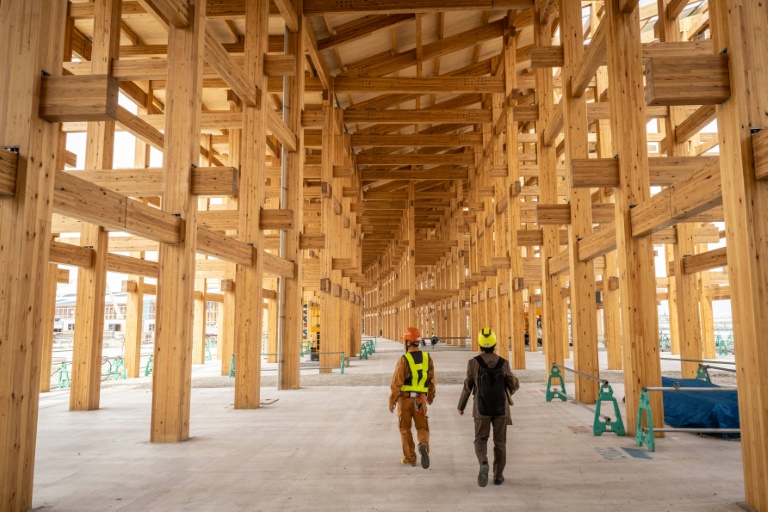Tokyo, 15 April, /AJMEDIA/
One of the largest wooden structures ever built is taking shape in Osaka, but hopes that Expo 2025 will unite the world are being dogged by cost blowouts and a lack of public enthusiasm.
The imposing circular centerpiece will be crowned by a 20-meter-high sloping canopy, designed by top architect Sou Fujimoto, known as the “Grand Roof”.
It has a circumference of a staggering two kilometers and 161 countries and territories will show off their trade opportunities and cultural attractions at pavilions within the vast latticed ring.
A crane hoisted a block of beams into place this week as organizers said construction was largely on schedule, one year before visitors will be welcomed.
Expo 2025 global PR director Sachiko Yoshimura maintained that global participants would be “united” by the event even though there are conflicts in Ukraine, Gaza and elsewhere.
Russia will not be among the participants at Expo 2025, which will run from April 13 to October 13.
“Of course there are so many crises around the world, but we want everybody to actually get together and think about the future and sustainability,” Yoshimura said.
It has also met a lukewarm response in Japan, where promotion is ramping up and the red-and-blue Expo 2025 mascot “Myaku-Myaku” — billed by the official website as “a mysterious creature born from the unification of cells and water” — is ever-present.
A recent Kyodo News survey found that 82 percent of Japanese companies, sponsors and others involved said “fostering domestic momentum” would be a challenge.
Ballooning budget
The construction budget has ballooned 27 percent from 2020 estimates to 235 billion yen due to inflation and Japan’s chronic worker shortage.
Some say the costs are also hard to justify when 6,300 people are still in evacuation centers and hotels after an earthquake on New Year’s Day devastated parts of central Japan.
Fujimoto’s “Grand Roof” alone has a price tag of 35 billion yen and has been slammed by opposition leader Kenta Izumi as “the world’s most expensive parasol”.
The “Grand Roof” and other structures are temporary, with no clear plan for them other than organizers saying they will be reused or recycled.
The site on an artificial island in Osaka Bay will be cleared after the Expo, with plans to build a resort there containing Japan’s first casino.
Jun Takashina, deputy secretary general of the Japan Association for Osaka 2025, acknowledged budget and regulatory “struggles” among foreign participants but said organisers would help make sure the displays are ready in time.
Among the most hotly anticipated attractions are flying electric cars, which take off vertically, showcasing the event’s technological and environmental aspirations.
But the vehicles — subject to reams of regulations — will be a “kind of experiment”, Yoshimura said.
More than 1.2 million tickets have already been sold and organizers hope to attract 28.2 million visitors, including 3.5 million from abroad.
That would be four million more than the last World Fair in Dubai but pales in comparison to the 64 million people who attended the 1970 Expo in Osaka, a record until it was overtaken by Shanghai in 2010.
The first world fair to celebrate culture and industrial progress was held in London in 1851, with the Eiffel Tower built for the 1889 Paris World Fair.
Osaka academic Shinya Hashizume, a specialist in architecture history and town planning, said he was amazed as a 10-year-old when he saw a “future that looked like science fiction” at the 1970 Expo.
The first film in IMAX format was shown at that event and visitors could admire rocks brought back from the moon.
“Those six months were extraordinary for Osaka. Simply put, the whole town was having a party,” he said.
The advent of mass tourism and hyper-connected societies may have since lessened the attraction but some Osaka residents still think it’s a good idea.
Kosuke Ito, a 36-year-old doctor, said it would “strengthen the economy”.
However, Yuka Nakamura, 26, said she might be put off by adult entry fees ranging from 4,000 to 7,500 yen a day.









































